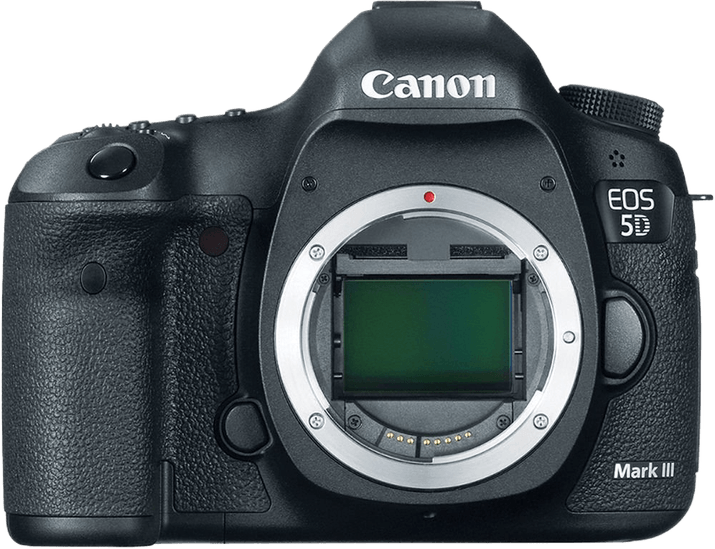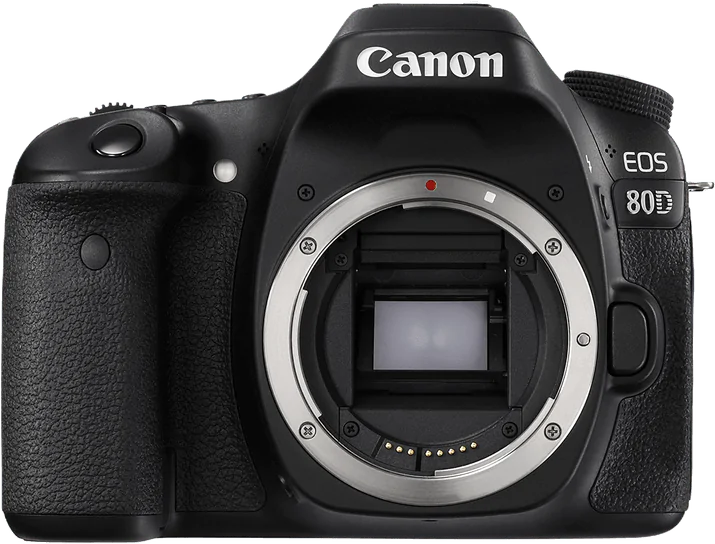Canon EOS 5D Mark III vs EOS 80D Comparison
Canon EOS 5D Mark III

Canon EOS 80D

The Canon EOS 5D Mark III narrowly outperforms the Canon EOS 80D with a score of 65/100 compared to 64/100. Both cameras are DSLRs and share similar specifications. However, the 5D Mark III has its advantages, such as being released in 2012 with a launch price of $3499, showcasing its premium quality. Its dimensions are 152 x 116 x 76mm, and it weighs 950g (2.09lbs).
On the other hand, the EOS 80D was released in 2016 with a more affordable launch price of $1200. It is slightly smaller and lighter, with dimensions of 139 x 105 x 79mm and a weight of 730g (1.61lbs). Despite the close scores, the 5D Mark III’s higher score reflects its superior performance, while the 80D offers a more budget-friendly option with a compact design.
Canon EOS 5D Mark III vs EOS 80D Overview and Optics
The Canon EOS 5D Mark III wins the optics comparison with a score of 67/100, while the Canon EOS 80D scores 63/100. Both cameras share some common specifications: they both have a CMOS sensor, a Canon EF lens mount, and no image stabilization. However, the 5D Mark III has a few advantages over the 80D that contribute to its higher score.
The 5D Mark III has a full-frame sensor, which is larger than the APS-C sensor found in the 80D. This larger sensor allows the 5D Mark III to capture more light, resulting in better image quality and improved low-light performance. Additionally, the 5D Mark III has a higher DXOMARK score of 81 for its sensor, compared to the 80D’s score of 79.
The 5D Mark III also features a Digic 5+ processor, which is a slightly more advanced version than the Digic 6 processor found in the 80D. This difference in processors may contribute to the 5D Mark III’s better image quality and overall performance.
On the other hand, the 80D has a higher megapixel count (24.2) than the 5D Mark III (22.3). This means that the 80D can capture more detail in images, which can be an advantage for certain types of photography, such as landscapes or architecture. The 80D also has a faster shooting speed of 7 frames per second, compared to the 5D Mark III’s 6 frames per second. This could be beneficial for action or sports photography.
Despite the 80D’s advantages in megapixel count and shooting speed, the 5D Mark III’s larger sensor, better low-light performance, and more advanced processor make it the winner in this optics comparison.
Canon EOS 5D Mark III vs EOS 80D Video Performance
The Canon EOS 80D is the winner in video capabilities, scoring 70/100, while the Canon EOS 5D Mark III scores 56/100. This 14-point difference shows that the EOS 80D has a more advanced video feature set compared to the 5D Mark III.
Both cameras share some common specifications, such as Full HD (1920 x 1080) maximum video resolution and 60fps maximum video frame rate. However, the EOS 80D possesses a key advantage: built-in time-lapse functionality. This feature allows users to create stunning time-lapse videos without the need for additional equipment or software, making it more convenient for videographers.
Despite the EOS 5D Mark III’s lower video score, it still offers reliable Full HD video recording at 60fps. This makes it suitable for capturing high-quality footage in various scenarios. However, its lack of built-in time-lapse functionality may be a drawback for some users who require this feature for their projects.
Comparing the two cameras, the Canon EOS 80D is superior in terms of video capabilities due to its higher score and built-in time-lapse functionality. This makes it an ideal choice for videographers who prioritize convenience and advanced features. On the other hand, the Canon EOS 5D Mark III remains a viable option for those who can overlook the absence of time-lapse functionality and still want a camera with solid video performance. Ultimately, the choice between these cameras depends on the specific requirements and preferences of the user.
Canon EOS 5D Mark III vs EOS 80D Features and Benefits
The Canon EOS 80D emerges as the winner in the features category with a score of 70 out of 100, while the Canon EOS 5D Mark III trails behind at 59 points. Both cameras share some common specifications such as screen resolution, which is 1040000 dots, and the absence of GPS and Bluetooth features.
The EOS 80D outperforms the 5D Mark III in several aspects. It boasts a touchscreen, allowing users to navigate menus and settings with ease. Additionally, the 80D has a flip screen, providing flexibility while shooting from different angles or capturing self-portraits. The inclusion of Wi-Fi in the 80D is another advantage, as it enables seamless image transfer and remote control via a smartphone.
On the other hand, the 5D Mark III has a larger screen size of 3.2 inches compared to the 3-inch screen of the 80D. However, this does not make a significant difference in the overall user experience as both cameras have the same screen resolution.
In terms of features, the Canon EOS 80D is a better choice due to its touchscreen, flip screen, and Wi-Fi capabilities. These added features enhance the user experience and provide added convenience for photographers. The 5D Mark III falls short in this comparison, with its only advantage being a slightly larger screen. However, this does not outweigh the benefits offered by the 80D. Therefore, the Canon EOS 80D is the superior choice when considering features.
Canon EOS 5D Mark III vs EOS 80D Storage and Battery
The Canon EOS 5D Mark III outperforms the Canon EOS 80D in storage and battery, scoring 76/100 compared to the 80D’s 43/100. Both cameras share similarities such as accepting SD/SDHC/SDXC memory cards and lacking USB charging capabilities. However, the 5D Mark III has two memory card slots, compared to the 80D’s single slot, and also accepts Compact Flash and UDMA cards. This additional storage capacity makes the 5D Mark III superior in this aspect.
In terms of battery life, the 80D does have a slight edge, offering 960 shots compared to the 5D Mark III’s 950 shots. Both cameras use similar battery types, with the 5D Mark III using the LP-E6 and the 80D using the LP-E6N. Despite the 80D’s marginally better battery life, the 5D Mark III’s overall storage and battery capabilities make it the stronger choice between the two.
Canon EOS 5D Mark III vs EOS 80D – Our Verdict
Are you still undecided about which camera is right for you? Have a look at these popular comparisons that feature the Canon EOS 5D Mark III or the Canon EOS 80D:

